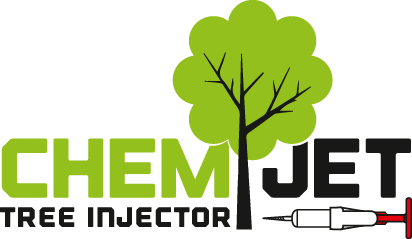Hemlock Woolly Adelgid Treatment
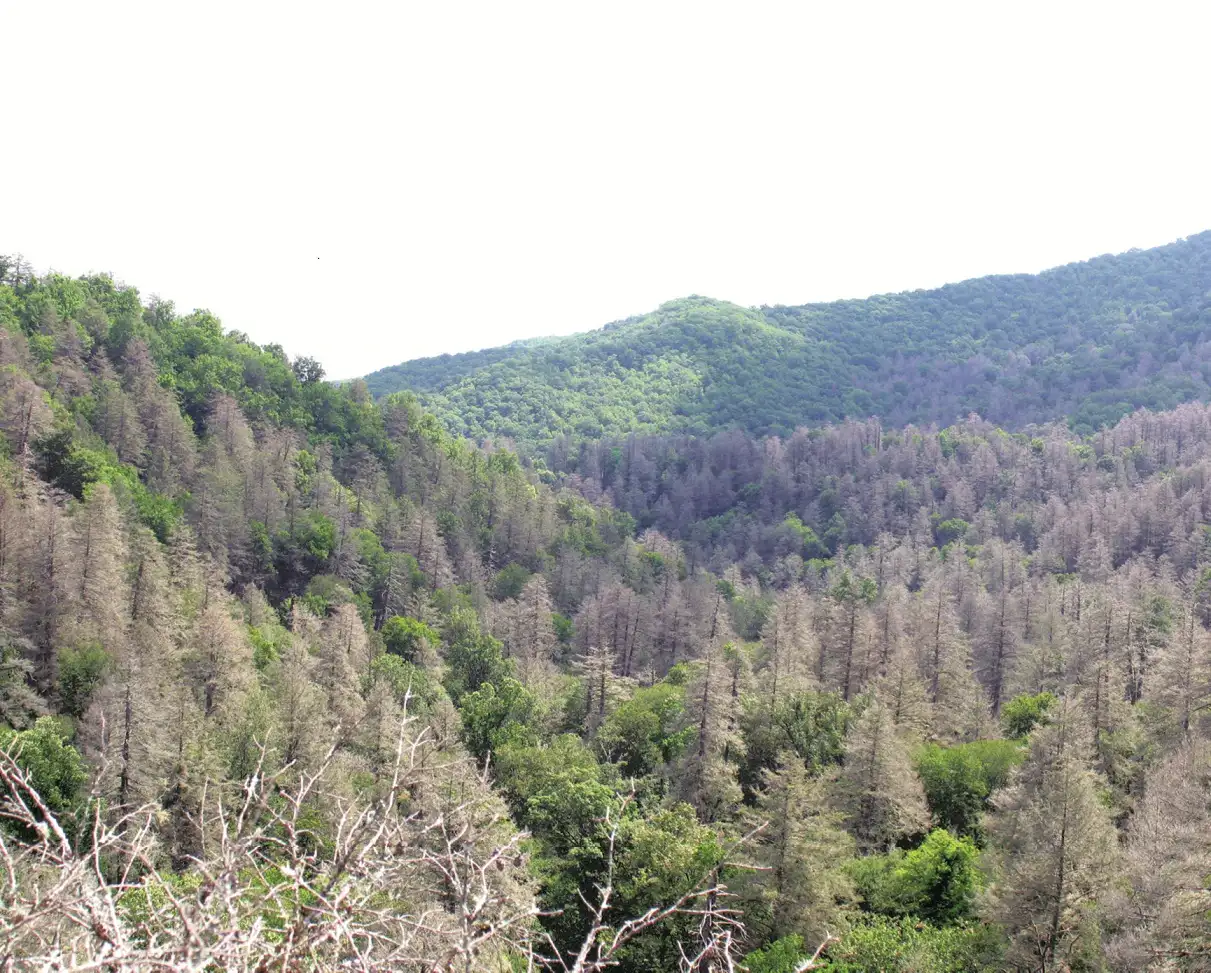
Hemlock Woolly Adelgid Treatment
Pesticides can be used for hemlock woolly adelgid treatment to save hemlock trees. Proactive management is necessary to combat the HWA to avoid infestation and death of healthy trees. HWA can be managed with a variety of strategies that prevent new infections and can actually save trees that are lightly infested. Hemlock woolly adelgid is a very small non-native aphid like insect that infests hemlock trees, eventually killing the trees within about six years.
Distribution of Hemlock woolly Adelgid Infestation
This insect was first found in North America, in 1951 in Virginia and has since expanded to include numerous states in the eastern US. It has recently been found in southwest Michigan.
Other Treatments and Info
- Oak Wilt Prevention and Treatment
- Save Your Trees from Oak Wilt
- Microinjection to Protect Trees From Oak Wilt
- Emerald Ash Borer Treatment
- Dutch Elm Disease
- Pine Bark Beetle Injection Treatment
- Sudden Oak Death
- Hemlock Woolly Adelgid Treatment
- Asian Longhorned Beetle Treatment
- Caterpillars, Beetles, Borers
- Orchard Crops Treatment
- Plugs for Tree Injection Holes
- Chemjet Tips and Ideas
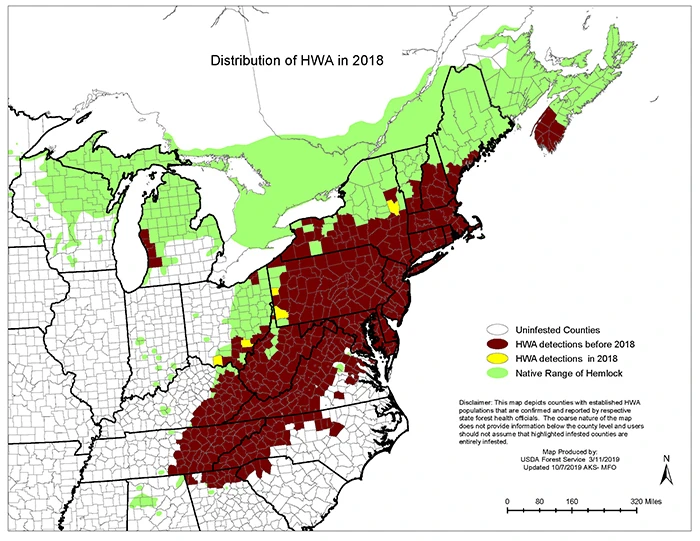
How Hemlock Woolly Adelgid Kills Trees
The woolly adelgids are so small that the individual bugs are difficult to see. They have a white cotton-like furry covering on their bodies and egg masses that is visible when numerous adelgids infest the areas along the branch tips. The HWA feed on sap at the base of the hemlock needles during approximately October through June, which kills the needles and they fall off, defoliating the tree. The HWA are dormant and do not feed during approximately July through September. It takes about 4 to 6 years for the infestation to stress the hemlock tree enough for numerous large branches to die back, and eventually the tree is killed. But the good news is that the white furry infestation along the needle twigs are noticeable and, with adequate treatment, the HWA can be removed. If a tree is not too far gone (too many dead branches) then it can be saved.
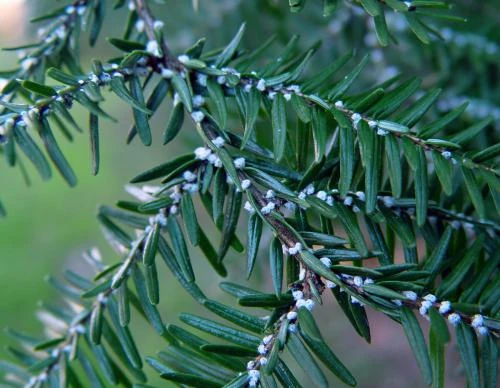
HWA Control
HWA is spread primarily by the wind, and by birds and mammals. They stick to the fur and feathers and are transported as hitchhikers. Work is being done to identify and use native parasitic predators that feed on HWA, but this solution is in the early study stages. The conventional preventative and corrective responses for an invasive species outbreak are being pursued as detailed below.
Do Not Transport Infested Wood
Cutting up trees infected by HWA for lumber, firewood or tree trimming and transporting the infected wood to new areas will transport the HWA to infest and kill trees in these areas. Do not transport any wood, bark or brush from HWA killed trees.
Chemical Treatment
HWA kills hemlock trees but it takes years and there is time to identify the infestation and take action to save trees. Chemical insecticide treatments can be conducted to protect and save valued trees. These applications include drenching the soil around the tree with insecticide, spraying the tree trunk, and trunk injection treatments. If done properly, the insecticide will kill the resident HWA and keep new infestation away from the trees. If a tree is lightly infested, the insecticide treatment kills the HWA and the tree can start to heal and ultimately thrive again.

- Soil Drenching
This method involves mixing the appropriate concentration and volume the insecticides imidacloprid, or dinotefuran diluted with water, and pouring onto soil or injecting into the soil around the base of the tree. The tree roots take up some of the insecticide as it moves downward through the soil, then the treatment is circulated throughout the tree, leaves to roots. Soil application of insecticides can several weeks or months to reach the effective levels throughout the tree.
This method is relatively simple and easy to perform by landowners and the comparatively inexpensive. There are good instructions on the bottle labels for how to mix and apply as a soil drench around the trees.
There are environmental and and potential human health risks associated with soil drenching for EAB control. Dumping many gallons of insecticide on the ground could cause insecticide to migrate past the tree roots downward through the soil, potentially causing groundwater contamination. Also the ground surface around the tree could be a source of potential toxic exposure of pesticide to unintended receptors such as honey bees and other beneficial insects, and humans or animals that use the area.
- Trunk Injection
Direct injection of pesticides through the bark and into the trunk of hemlock trees is an environmentally sound and economical way of treating HWA. With direct injection into the circulatory system of a tree, a much lower volume of chemical is needed because it all goes into the tree, leaving none on the ground or on the exterior tree bark for exposure to unintended receptors. Trunk injection is the most efficient and works the fastest of HWA control methods, with the pesticide circulation throughout the tree within a few days. Trunk microinjections should be conducted during spring after other trees have leafed out and throughout the summer.
Healthy or lightly infested hemlock trees can be treated using an insecticide to prevent infestation by HWA. This can be easily conducted using Chemjet® Tree Injectors to inject specialized insecticides into small drilled holes at several locations around the circumference of the tree. The chemical is then carried throughout the tree, from up to the needles down to all of the roots, effectively killing HWA currently in the tree. Several insecticides can be used for injection treatment for hemlock woolly adelgid, including injectable imidacloprid like Ima-Jet and injectable acephate like Ace-Jet.
- Acephate
Acephate is a relatively inexpensive injection treatment chemical. Is quickly taken up throughout the tree and may start killing HWA in a few hours, and then degrades within three to five weeks. So it is quick to start but short acting. Often the approximate one month period of effectiveness is all that is needed to knock the bugs out of your tree that are from a single hatch or seasonal outbreak. But because of the relatively short effectiveness period of acephate, injections of acephate should not be conducted during the time period that HWA are dormant during July through September. An injectable acephate brand is Ace-Jet. There are other brands of 97% to 98% acephate available as well. Using the labeled medium dosage for application of Ace-Jet, an example application using Chemjet Tree Injectors filled to 20 ml placed at 6 inch intervals around the tree trunk with following chemical mixture ratio: 10 grams of Ace-Jet granules per 100 ml of water.
Again, the HWA are dormant and do not feed during approximately July through September. So inject hemlock trees in the spring or after September.
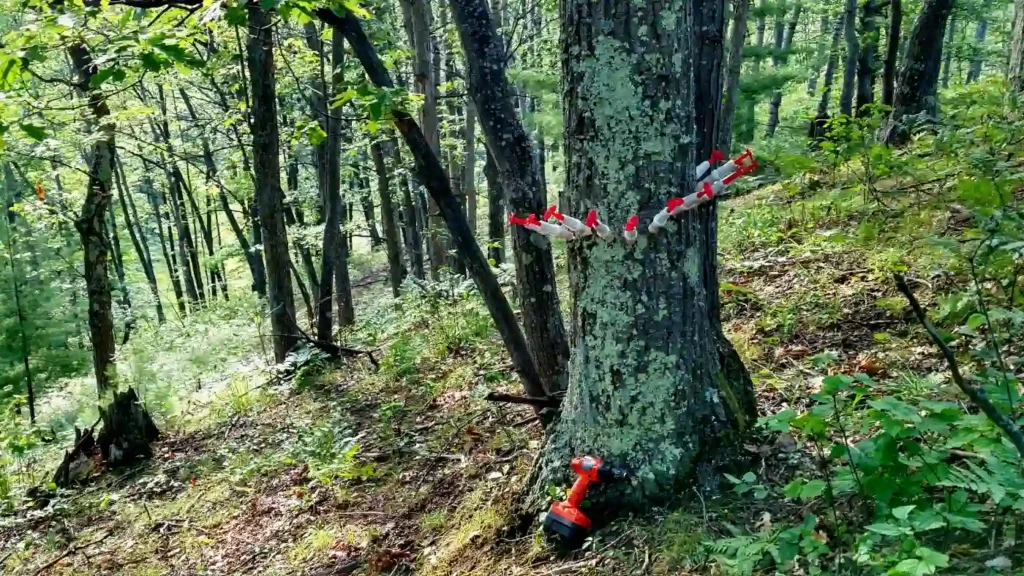
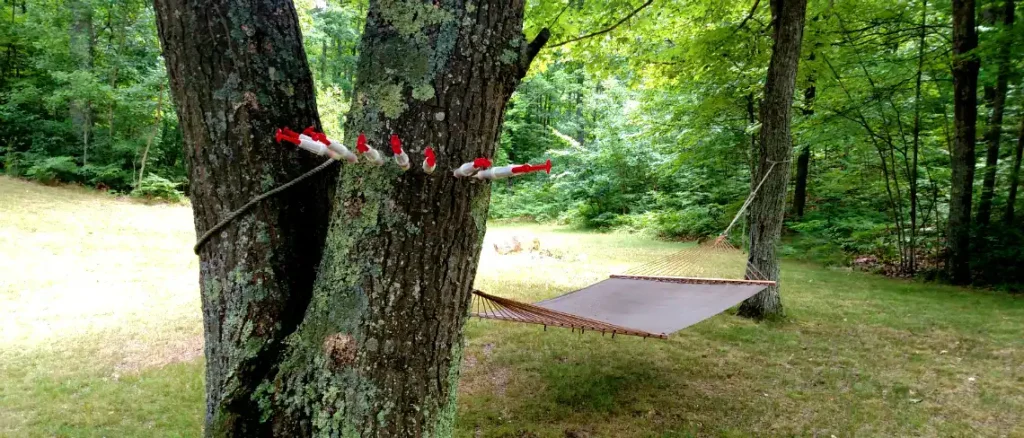
- Imidacloprid
Is a moderately expensive injection treatment chemical. Is taken up by the tree relatively slowly and may start killing HWA after a few days. Injected imidacloprid may continue to kill chewing bugs in the tree for up to a year with one injection. Because of the longer residual effectiveness, imidacloprid will perform better for pest problems that are ongoing throughout a longer time period, like all summer. The product Ima-Jet 5% is commonly used and there are other brands of injectable imidacloprid available as well.
Note: The imidacloprid formulation (milky color) used for soil drench described above will not work in tree injectors. It contains an insoluble powder that quickly clogs up the hole drilled in the tree.
Using the labeled maximum dosage for application of Ima-Jet 5%, an example application using Chemjet Tree Injector is 8-inch spacing between injection points around the circumference of the tree using Chemjet Tree Injectors filled with 20 ml of Ima-Jet 5%. Injectable imidacloprid should not be diluted with water.
Using either injectable pesticide discussed above, the objective is to kill all of the HWA in your hemlock tree once per year, or as otherwise necessary due to proliferation of the pest based on observation the new occurrence of the insects and their white fuzz, or dead hemlock needles.
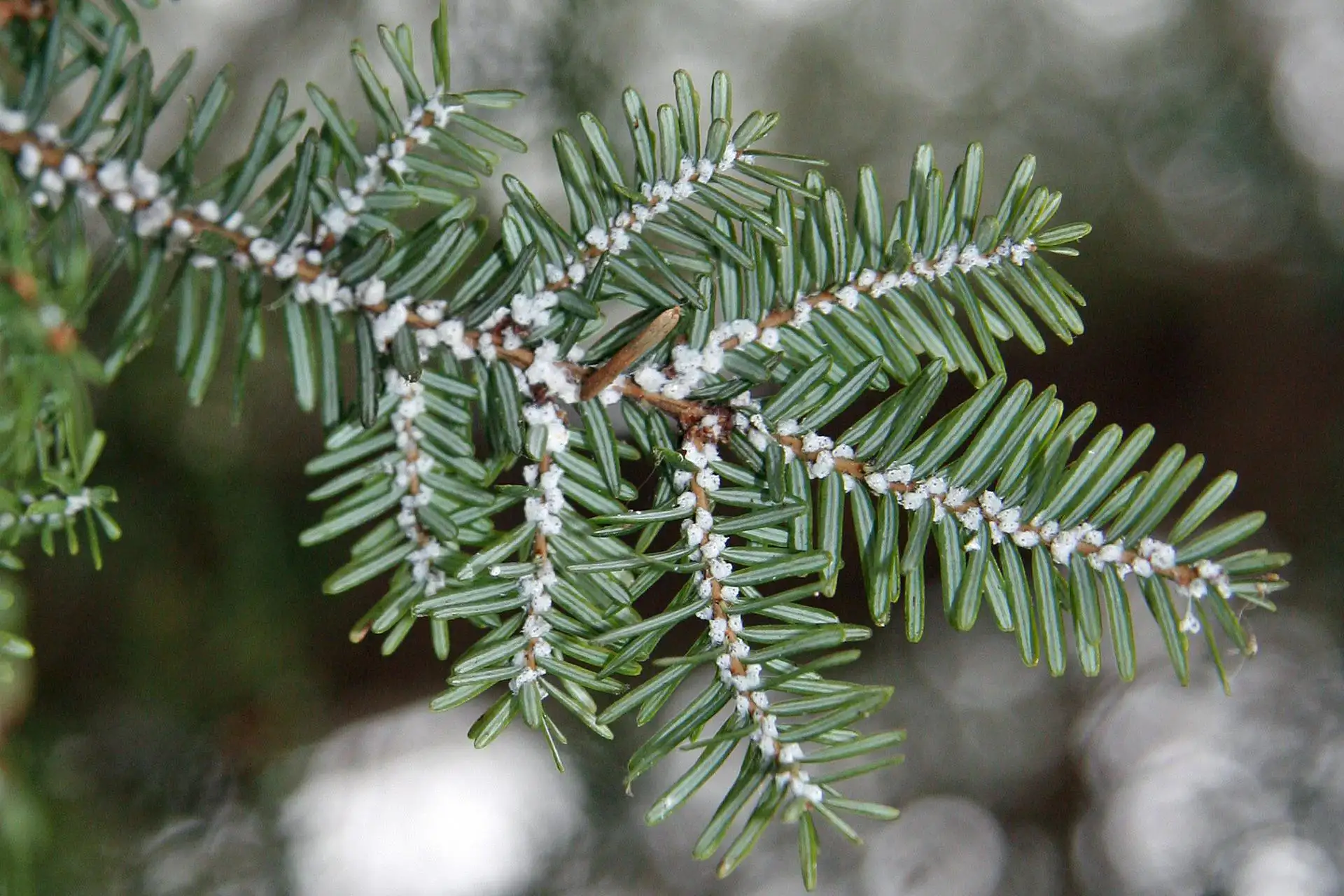
Injection Procedure for Hemlock Woolly Adelgid
This example injection procedure for HWA is adapted from the Chemjet® manufacturer suggested procedure . You can inject at the root flare just above the ground, or at some point up the trunk that is easier to reach.
- Confirm with a qualified arborist or biologist that this procedure is appropriate for your tree. You may not have a HWA risk or there may be other circumstances that would cause this procedure to be inappropriate. Also there may be a risk that this procedure may harm your tree.
- Only inject hemlock trees during the seasonal time period necessary to be effective for treatment of HWA (during warm months when transpiration is occurring, indicated by green leaves on other trees).
- In southern states try to inject trees after a period of rain or after substantial watering. Do not inject trees during sustained drought conditions.
- Follow personal protection recommendations from the treatment chemical label. This would generally include wearing rubber gloves and safety goggles during all mixing, injection and cleanup work.
- Disinfect Chemjet® injector and drill bit by washing and scrubbing in diluted bleach solution or Lysol disinfectant solution. Pull disinfectant solution through the nozzle filling the injector several times. Rinse with clean water.
- Prepare the insecticide injections per the instructions on the label from the chemical you are using.
- Drill the first three holes at intervals around tree at 45 degree angle downward no more than 1.25 inch deep. Only use a 11/64 drill bit. Drilling more than three holes may heat up the bit and scorch the wood which will inhibit injection.
- Pull the chemical mix from step 6 into the injector until full at 20 ml and lock the handle back while twisting.
- Insert into recently drilled hole. Push into place and seal (don’t twist because the nozzle may break).
- Using both hands, hold the Chemjet® in place and then twist and release the red plunger so that injection begins. If there is leakage push the nozzle in harder to seal. Repeat for remaining two holes.
- After all chemical is in tree, pull injector straight out of hole. If chemical starts oozing back out of open hole, replace Chemjet® and leave there for another half hour or use a plug.
- Repeat with three more holes, going around tree.
- If an injector is taking chemical slowly, leave it in place and move on. It could take up to 24 hours.
- IMPORTANT: Disinfect drill bit and all Chemjets (inside and out) before using on any other tree per step 6. Disinfect your hands and put on new rubber gloves to avoid potential for transferring diseases to next tree.
- Take Care of your Chemjet® Tree Injectors after the work is done (or during long term work at least once per week) so they keep working smoothly by disassembling, washing all parts with hot soapy water, rinse and air dry, then lubricate the nozzle barrel and rubber plunger washer with silicone lube or vegetable oil before reassembly.
Here is a Video.
Other Treatments and Info
- Oak Wilt Prevention and Treatment
- Save Your Trees from Oak Wilt
- Microinjection to Protect Trees From Oak Wilt
- Emerald Ash Borer Treatment
- Dutch Elm Disease
- Pine Bark Beetle Injection Treatment
- Sudden Oak Death
- Hemlock Woolly Adelgid Treatment
- Asian Longhorned Beetle Treatment
- Caterpillars, Beetles, Borers
- Orchard Crops Treatment
- Plugs for Tree Injection Holes
- Chemjet Tips and Ideas
